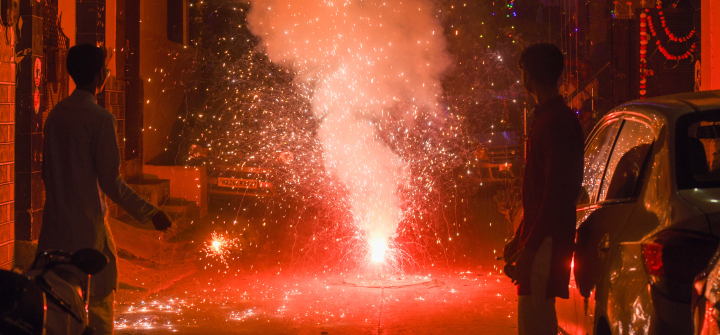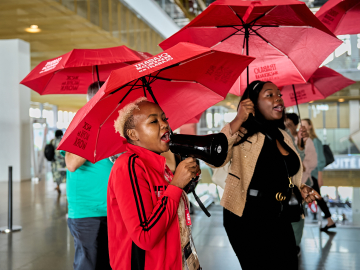‘Invisible Suffering’: Deadly Risks in India’s Fireworks Factories
SIVAKASI, India—The explosion at the Neerathilingam Fireworks factory on an otherwise quiet Wednesday afternoon was the loudest, most terrifying noise she had ever heard.
February 19, 2025 was the nightmare that Kandiyarammal, 33, had always tried to avoid thinking about.
Her cousin Palpandey, 31, was mixing chemicals near her when the explosion shattered his life.
“It was terrifying, and it came without any warning,” Palpandey told Global Health NOW from his hospital bed just days after the blast.

Palpandey, a victim of the fireworks explosion, sits on a hospital bed, with Kandiyarammal standing at his side. Kamala Thiagarajan
The Explosion
Palpandey shares the room in the burn unit of the Government Rajaji Hospital with three other patients. As he spoke, visitors milled about the room. A glass partition and a thin curtain separated Palpandey’s single bed from the others. The room is not air-conditioned.
The explosion shattered bones in both his legs and broke his right arm. His face is covered in scars from third-degree burns, and both his eyes have been badly damaged. Some vision remains in his left eye.
“One moment, everything was fine, and the next, I felt the ground shaking beneath me and I was thrown into the air,” Palpandey recalls. When he fell, a searing pain shot through his legs and his right arm. But it was the burning in his eyes that caused him to panic.
“I couldn’t see anything but darkness, and I couldn’t open my eyes,” he says. “I’ve never felt fear like that in my life.”
After the initial explosion, a raging fire broke out. The other workers had only seconds to rush to safety. They knew subsequent, worse explosions could follow. Everyone around Kandiyarammal fled, but she began looking for her cousin after hearing his cries. “Palpandey had helped me and my young children tide over so many tough situations over the years. I couldn’t just abandon him,” she says.
Finding him sprawled on the ground, she and a colleague hoisted him on their shoulders. As they ran to exit the shed, they heard the cries of another colleague—a 35-year-old worker named Suresh who was severely injured. The explosion had started with his batch of chemicals.
Deaths in the Factories
Explosions in fireworks factories like Neerathilingam are all too common in Sivakasi and the surrounding villages in the Virudhunagar district of Tamil Nadu state. Sivakasi produces nearly 90% of the country’s fireworks and employ up to 100,000 workers like Kandiyarammal and Palpandey (like many in Southern India, both use only their first names).
Despite its commercial success, the city's fireworks factories are among the most dangerous places to work in India. Although data on worker deaths is sparse, 91 people were killed in 36 fireworks manufacturing accidents nationwide between April 3, 2023 and March 28, 2024, according to the 2023–2024 annual report of the Indian government's Petroleum and Explosives Safety Organisation (PESO). But a review of newspaper articles in 2023 and 2024 by the media site newslaundry counted 76 deaths just six months.
“At least 50–100 people die every year from fireworks accidents,” says Vijay Kumar, a social activist and director of the Human Resource Foundation, a small NGO that aids fireworks factory victims in the Sivakasi area. Kumar notes that the government counts only include those killed at the manufacturing site, but some workers die from burn injuries weeks, months, and even years later.
“The suffering of these people who die later is invisible—they don’t show up on government counts of deaths,” he says.
Uncertainty is part of the job at the many fireworks factories that dot the landscape in and around Sivakasi. Every day, sacks of silvery aluminum powder, potassium nitrate, sulfur, and other chemicals are mixed by hand in factory sheds. By lunchtime, workers who handle this job are covered from head to toe in a fine layer of silver dust.
The chemicals are dangerous, yet they are given no special safety training or protective equipment, or even gloves, Kandiyarammal says.

Inside a fireworks factory. Courtesy: Pyro India News
Higher Pay but Great Risks
Separated from her husband and caring for two young sons, Kandiyarammal believed that dwelling on the dangers of her job would do her no good. She understood the risks. She had trained as a nurse but chose to work in a fireworks factory because she was earning double her average nursing pay. She earns $6.50 (INR 500) a day at the factory.
Most labor in Sivakasi is informal by untrained people drawn from surrounding villages. Many work 10-hour shifts, from 8 a.m. to 6 p.m. every day, including Sundays.
In the assembly line of firecracker manufacturing, Kandiyarammal’s job is to punch thin wicks into rolled-up cardboard tubes filled with the powdered mixture. A layer of mud stops up one end of the firecracker and the wick becomes the fuse. Up to 40 of these mud- and chemical-filled tubes are placed in every inch of a circular mold. Workers tap the bottom of the mold to release the firecrackers, which can then be packaged.
To do this job, Kandiyarammal must sit cross-legged on the floor for hours. All work is done by hand.
On the day of the explosion, 10 other women were crowded in the small shed with her, punching wicks. Kandiyarammal was working just a couple of feet from her cousin and another male worker. Palpandey had worked in Sivakasi’s firecracker factories since he was 15. Chemical mixers have no formal education, but he earned around $10.29 (INR 900) per day—far more than what many women workers earned in the same factory.
By law, the workers mixing chemicals should operate in a separate shed, away from the others. They should each be stationed by a doorway, allowing for a quick escape should there be an explosion. In reality, however, other workers often assigned to the mixing sheds, making conditions not just cramped and uncomfortable but dangerous.
Long working hours, the lack of adequate training in handling chemicals, and disregard for safety procedures such as isolation of workers mixing chemicals are among the reasons for the explosions and fires in fireworks factories, according to a 2018 Shanlax International Journal of Management article.
Even licensed fireworks factories can have unauthorized sheds on their premises, in order to make more fireworks than legally allowed. Many of the lethal fireworks explosions and fires documented in the PESO report were connected to unauthorized factories. An October 2023 blast in Sivakasi’s Mangalam village, for example, took place in an unauthorized shed and killed 13 people and injured two. The lack of regular inspections allows such unauthorized sheds to thrive, activists and workers say.
Even licensed factories skirt the rules. A July 2023 blast in Attibele, Bangalore, that killed 13 workers occurred in a fireworks shop whose 505 square meters far exceeded the 25 square meter limit maximum and mixed both storage and manufacturing work, which is against regulations.

Women make outer shell of the firecracker—work that can be done safely outside. Sivakasi, India. Kamala Thiagarajan
The Hazards of Firecracker Labor
No one really knows how many factories are scattered across the scrublands of this arid city of 340,000 people. Sivakasi’s economy also relies on matchstick manufacturing and printing, but the fireworks industry is king, producing 50,000 tons of firecrackers every year with an estimated annual revenue of $60 million. Officially, there were 1,434 registered fireworks factories in all of Tamil Nadu in 2022, but that number is almost certainly an undercount. A 2023 article in the International Journal of Research and Analytical Reviews puts the number at 8,000.
The manufacturing process takes place in a series of small rudimentary sheds—with cement floors, bare brick walls, and asbestos roofing (a cheap and readily available material). Some of the larger factories have as many as 40 to 50 sheds on sprawling campuses. Each shed is a small room, where part of the firecracker production process takes place. Chemicals are mixed by hand, then manually pressed into pellets and topped up with chemical salts that provide color and sparkle. Copper salts, for example, are added for blue sparks and barium salts for green. Finally, the wick is punched and the firecracker sealed.
The sheds meant for the mixing of chemicals have as many as two to four exits. Workers who mix chemicals in these rooms are expected to be alert to danger—positioned by doorways and ready to flee for safety in case of the slightest spark. But in practice, many workers are crowded into the sheds—so explosions can affect even those who don’t directly handle the chemicals.
At the heart of all fireworks is gunpowder, also called black powder. Its recipe has remained essentially the same since it was created in China over a thousand years ago: 75% is saltpeter—or potassium nitrate—an oxidizing agent that allows the firecracker’s contents to burn. Up to 24% is aluminum powder, which creates explosions, flashes, and color. The metal salts are added to produce vibrant colors. Every fireworks factory has its own formulations, creating different types of fireworks.
The cause of explosions in fireworks factories is often unclear. Lightning strikes, mishandling of chemicals, smoking, using mobile phones, and loose electrical connections can all lead to explosions, according to the PESO report. The oxidizers and fuels in firecracker powder are sensitive to heat and touch. If they are rubbed together, the heat generated could cause a spark and set off an explosion—what’s called friction-induced ignition.
That may have been the cause of the February 19 explosion.
“His Cries Still Haunt Me.”
As Kandiyarammal and a coworker staggered out of the shed with Palpandey after the first explosion, she realized that she could not save their colleague Suresh. “I had to focus on getting Palpandey to safety,” says Kandiyarammal. “I was aware that an accident like this rarely ends with a single explosion.”
Then they heard the second explosion as they crossed the shed’s threshold. Suresh, who had no living relatives, and who sometimes slept on the streets or in the factory office, was killed.
“His cries still haunt me. They ring in my ears,” Kandiyarammal says, “but in that situation, there was little I could do.”
By the time firefighters arrived, the entire shed had burned to the ground. That evening, the yellow-helmeted firefighters hosed down a small pile of rubble, causing clouds of steam to rise. Blackened limbs of the trees that were nearest the fire loomed over them.
In the weeks that followed, a specialist would operate on Palpandey’s legs and his eyes; his employer had promised to cover all expenses, he says.
The owners of Neerathilingam Fireworks could not be reached for comment.
When asked about the measures taken to ensure basic safety for laborers, a Fireworks Research & Development Center (FRDC) official in Sivakasi said he was not authorized to speak with the press. (FRDC is part of PESO.) And officials at PESO’s main office in Nagpur, in the western Indian state of Maharashtra, did not respond to Global Health NOW’s request for comment.
The blasts at Neerathilingam Fireworks are not uncommon in Sivakasi, says Arun Kumar, a plastic surgeon specializing in the treatment of burns at Sivakasi government hospital. There, they see at least 40 cases a year, and it can take several years and multiple surgeries for victims to heal. While the victims are typically supported initially by their employers until they’re out of immediate danger, they’re often on their own in subsequent years of care, he says.
“Their lives change irrevocably. Even when second-and third-degree burns heal, there is significant scarring,” Arun Kumar says. “If a burn occurs along a joint of the body—such as the knee, a finger or an elbow, it affects elasticity. Using that joint can be difficult, even when the skin heals. The pain is immense.”
Additionally, burn victims inhale soot—the carbon coats the lungs, causing severe respiratory issues. And they must contend with barotrauma—a medical condition resulting from a sudden change in air or water pressure that can damage the eyes, ears, sinuses, lungs and other organs.
“Victims struggle to swallow food and lead a normal life,” he says.
Kandiyarammal stayed by Palpandey’s side at the hospital. A doctor had told the family he would probably regain his vision, though it would take two years for him to completely heal, she says.
“And yet, once he’s better, I’m sure he’ll find his way back to the firecracker factories again,” says Kandiyarammal. She herself returned to work at the factory. “There’s nowhere else to go if you want to make a decent living.
“In Sivakasi, this is what our lives are like,” she says.
Read part II of this series, “Fireworks and Heartbreak in a Hard-Hit Indian Village.”
Ed. Note: Our thanks go to Padmavathy Krishna Kumar, who shared the idea for this issue and received an honorable mention in the 2025 Untold Global Health Stories of contest, co-sponsored by Global Health NOW and the Consortium of Universities for Global Health.
Join the 50,000+ subscribers in 170+ countries who rely on Global Health NOW summaries and exclusive articles for the latest public health news. Sign up for our free weekday newsletter, and please share the link with friends and colleagues.
Millions of Indians celebrate the Diwali Festival with fireworks—without realizing the dangerous conditions factory workers in Sivakasi endure. October 31, 2024, Gurugram, India. Parveen Kumar/Hindustan Times via Getty Images




